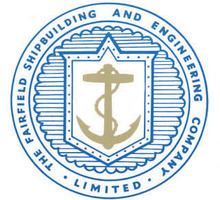Former type Public company Defunct 1968 Founded 1834 Ceased operations 1968 | ||
 | ||
Key people Charles RandolphJohn ElderSir William PearceSir James LithgowSir Alexander Kennedy | ||
The Fairfield Shipbuilding and Engineering Company, Limited was a Scottish shipbuilding company in the Govan area on the Clyde in Glasgow. Fairfields, as it is often known, was a major warship builder, turning out many vessels for the Royal Navy and other navies through the First World War and the Second World War. It also built many transatlantic liners, including record breaking ships for the Cunard Line and Canadian Pacific, such as the Blue Riband winning sisters RMS Campania and RMS Lucania. At the other end of the scale Fairfields built fast cross channel mail steamers and ferries for locations around the world. These included ships for the Bosphorus crossing in Istanbul and some of the early ships used by Thomas Cook for developing tourism on the River Nile.
Contents
History
Charles Randolph, who began trading as a millwright, founded the business as Randolph & Elliott by building engines and machinery in the Tradeston district of Glasgow in 1834. John Elder joined the business in 1852 and it then diversified into shipbuilding as Randolph, Elder and Company, acquiring the Govan Old Shipyard in 1858. The first ship was built in 1861 as No 14.
The business moved to a new yard at the former Fairfield Farm at the Govan riverside in 1864, changing its name to the Fairfield Shipbuilding and Engineering Company, after the old farm, in 1886, at which time it was owned by Sir William Pearce. The shipyard's imposing red sandstone Drawing Offices were designed by John Keppie of Honeyman and Keppie, with help from a young Charles Rennie Macintosh, and built 1889–91. The sculpted figures (The Engineer and the shipwright) flanking the entrance are by James Pittendrigh Macgillivray.
John Carmichael was manager of the Fairfield yard in 1894. He had been born in Govan in 1858 and had entered Fairfield as an apprentice in 1873. When his apprenticeship was completed seven years later, Sir William Pearce made him head draughtsman, and later he was promoted to assistant manager.
Alexander Cleghorn FRSE became the Fairfield manager in 1909. The company also established the Coventry Ordnance Works joint venture with Yarrow Shipbuilders and others in 1905.
The Fairfield Titan was built for the yard in 1911 by Sir William Arrol & Co., with a maximum lift capacity of 200 tons. It was acknowledged for many years as the largest crane in the World. It was employed in lifting the engines and boilers aboard ships in the fitting out basin. The crane was a Category B listed building but was demolished in 2007 in yard modernisation works.
In 1919 the company became part of the Northumberland Shipbuilding Company, with Alexander Kennedy installed as managing director. In 1921 Alexander Kennedy was knighted. Sir Alexander became Fairfield chairman in 1930 and remained so until after Fairfield was taken over by Lithgows of Port Glasgow in 1935, after Fairfield became entangled with the insolvency of the Anchor Line.
The Fairfield West Yard had been added at the outbreak of the First World War for submarine construction, but closed after ten years due to severe recession and was demolished by National Shipbuilders Securities in 1934. The Fairfield West yard site was later used by the United States Army Corps of Engineers in 1944 to build four landing craft.
In 1924, the company bought a shipyard at Chepstow on the River Wye in South Wales, previously developed as National Shipyard No.1 in the First World War and then taken over by the Monmouthshire Shipbuilding Company. The works later specialised in assembling bridges and other major structures.
In the 1950s the yard underwent a major £4 million modernisation programme which was implemented slowly over a period of ten years to minimise disruption to the yard. In 1963, the Fairfield engine building division merged with another Lithgow subsidiary, David Rowan & Company, to form Fairfield Rowan Ltd. Soon after the decade long shipyard modernisation works were completed, Fairfield Shipbuilding and Engineering Ltd and Fairfield Rowan Ltd were placed into receivership and was subsequently sold by Lithgow's in 1965. Fairfield's Chepstow works was sold to the Mabey Group in 1966.
The marine engine building subsidiary Fairfield Rowan was closed in 1966, but the modernised shipbuilding operation was reconstituted as Fairfield (Glasgow) Ltd, in what became known as the famous "Fairfield Experiment", into new ways of improving productivity through new reforms to industrial relations and the application of scientific management methods to improve productivity. The era of the Fairfield experiment was captured by Sean Connery in his documentary The Bowler and the Bunnet.
Then in 1968 the company was made part of Upper Clyde Shipbuilders, which collapsed in 1971 when a strike and work-in received national press attention. As part of the recovery deal, Fairfields was formed into Govan Shipbuilders in 1972, which was itself later nationalised and subsumed into British Shipbuilders in 1977. On the break-up of British Shipbuilders under denationalisation in 1988, the former Fairfield yard was sold to the Norwegian Kværner group and renamed Kvaerner Govan. The yard passed to BAE Systems Marine in 1999 and is now part of BAE Systems Surface Ships.
Ships built
Some of the better-known ships built by Fairfield's include:
